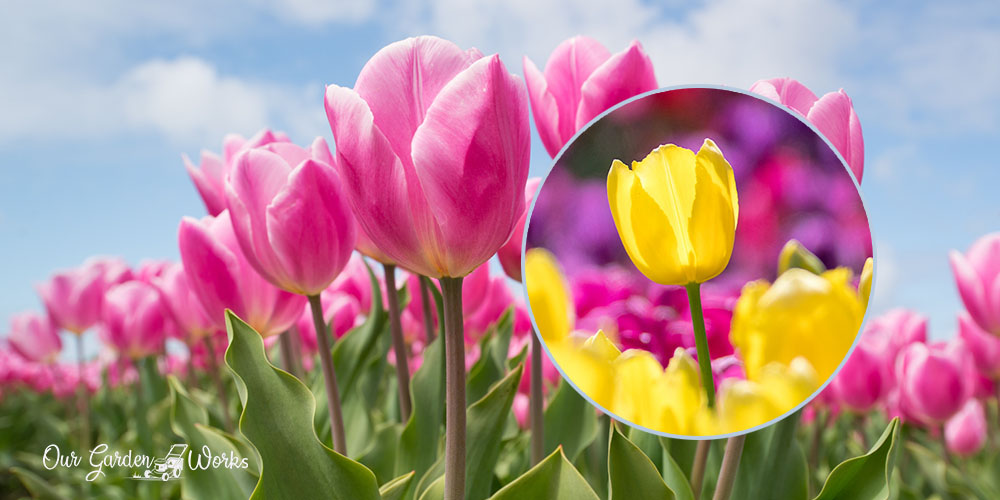Tulips are among the most favored flowers in the world. It has perfectly symmetrical and brightly colored petals that can brighten up any landscape.
As a spring-blooming bulb, tulips are easy to grow. You may see them indoors and in fields, so some people wonder: do tulips need sun exposure, or can they thrive in the shade?
In this post, we will share the sun requirements of tulips and how the sun and shade affect their overall health.
If you’re planning to see them bloom in your garden in the next spring season, we also included their other growing requirements and the techniques to grow them.
A tulip is a perennial bulb that emerges every growing season. It can grow from seed or bulb. However, bulbs tend to grow flowers faster than seeds.
Tulips that are grown from seeds require several months to germinate and years before they can develop flowers.
Q: Do Tulips Need Sun?
A: Tulips need direct sunlight sporadically throughout the day to bloom best. Despite their exquisite look, tulips are not very sensitive plants. They can endure a mix of slight shade and direct sunlight.
Due to this reason, they make a perfect addition to flower beds that get early morning sun and shade in the afternoon.
Tulips love basking in the direct sun but they also benefit from shade. Protecting them from the intense afternoon sun allows their blooms to last longer and help the plant mature better.
Two types of tulips namely, hybrids and species have the same tolerance to direct sun and shade but they are treated by gardeners differently.
Hybrids may tend to stop blooming after one growing season. So, most gardeners treat them as annuals while some prefer species tulips.
Species tulips are tulip varieties that have pointed petals compared to the rounded petal edges of hybrids. They have better chances of growing back every spring without any special treatment.
The best tulip species that you can grow at home according to Horticultural Mag are as follows:
- Lady tulip.
- Tarda tulip.
- Crocus tulip.
- Torkustan tulip.
- Wood tulip.
- Whittall’s tulip.
How much light do tulips need?
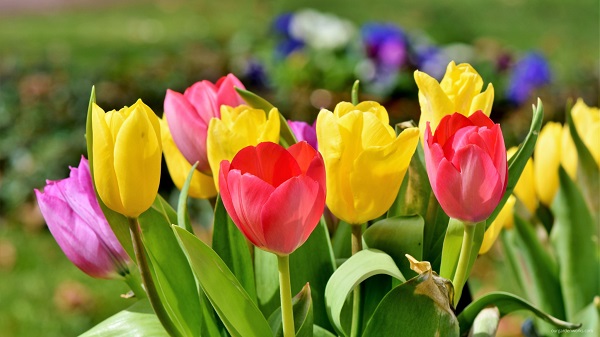
Tulips, both hybrids and species, need at least six hours of direct sunlight to bloom to their full potential. However, they still need partial shade, especially during the peak of summer heat.
Tulips can be sun tolerant but they are not a fan of extreme weather conditions. Therefore, it’s best to give your tulips the taste of both worlds by giving them direct sun in the morning and partial shade in the afternoon.
If you live in the southern or tropical states of the US, the extreme temperatures can cause more harm than good to tulips.
Tulips planted in the warm regions of the country will require protection from partial shade to avoid any sun damage.
Can tulips be in the shade?
Tulips can grow in partial shade but not in full shade. You may see them in vases indoors but they are placed in areas where there’s at least indirect sunlight.
Without adequate light conditions, tulips will fail to bloom, experience stunted growth, and even start rotting.
Tulip problems: Can tulips get sunburnt?
Excessive sun exposure can stress tulips. They can tolerate outdoor temperatures between 30°F to 55°F but if the climate gets beyond that range, the tulips may start to get damaged.
You’ll know that your tulips are suffering from heat stress or damage through the signs below.
- Falling petals.
- Droopy flowers.
- Petal discoloration.
- Curling petals.
- Wilting petals.
Did You Know? Did you know that tulip petals are edible? Tulip petals are very similar to the texture of onion but with a more earthy taste and peppery kick. However, other parts of the tulips are not safe to eat.
Other growing requirements of tulips
Now that you know the light requirements of tulips, why not discover the other growing requirements as well for your brief introduction to tulip cultivation?
Let’s start off with the watering requirements.
Watering
Tulips may not be picky when it comes to sun and shade but it is very sensitive to excessive moisture.
The only time you need to water them is during bulb planting before the ground freezes in the last weeks of fall, and when they’re experiencing drought stress. Other than that, you can leave them unwatered.
Learn more about how often you should water tulips in our separate post here.
Fertilization
Tulips can already benefit from all-purpose fertilizers with an NPK ratio of 10-10-10. They only need to be fed twice a year which is during spring and fall.
After planting new tulip bulbs in the fall, topdressing the soil with organic material like compost can help prepare them for the next spring.
Fertilizing tulips in spring allows it to have enough support as it develops new roots in summer.
Adequate feeding is needed to boost their bloom performance in spring. Otherwise, they may not bloom and even have stunted growth.
Soil requirement
Tulips are moisture-sensitive, so the soil must be well-draining and not retain too much water. They perform better in sandy soil than clay. Tulips also thrive in a slightly acidic environment with a soil pH level between 6.0 to 6.5.
Nourish the soil with organic materials and avoid adding peat moss and water-retaining soil amendments.
Temperature and climate
Most tulip varieties are cold-loving and thrive in temperatures between 30℉ to 55℉. They require about 3 to 4 months of cold weather to grow and show off their blooms. They do not grow well in warm climates that’s why they also experience sun damage when the weather is too hot.
During summer, the tulips will start to wither and die back. The blooms only last as long as there’s cool weather. When it starts to get warm, the flowers can only last for a few days to a week.
How to grow tulips in your garden
Planting tulip bulbs is easy and can be strategically done so you can enjoy early to late-season tulip blooms in your garden. Check out the planting steps below:
Choose tulip varieties for your garden
Tulips have varieties that bloom at different intervals, such as early season, mid-season, and late season. You can enjoy watching tulip blooms in your garden throughout spring until the first week of summer.
Check out the varieties that you can choose from each blooming period below:
Early-flowering tulips
Tulip varieties under this category bloom as early as March. If you want to welcome spring with blooms, here are some of the tulip varieties that you can grow:
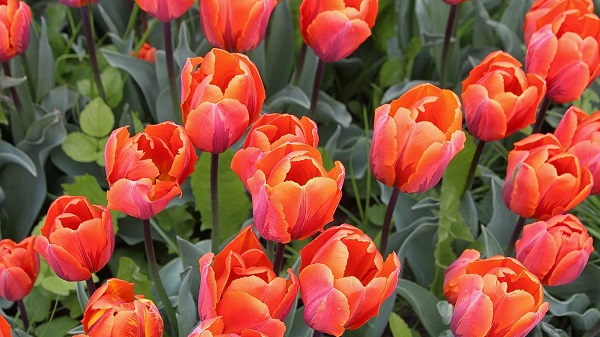
- Tulipa ‘Monte Carlo’.
- Tulipa ‘Keizerskroon’.
- Tulipa ‘Ancilla’.
- Tulipa ‘Purple Prince’.
- Tulip ‘Ice Stick’.
- Tulipa ‘Sunny Prince’.
Mid-season tulips
Mid-season tulips bloom from April to May and include more tulip varieties than early and late-season tulips. Tulip varieties in this category are as follows:
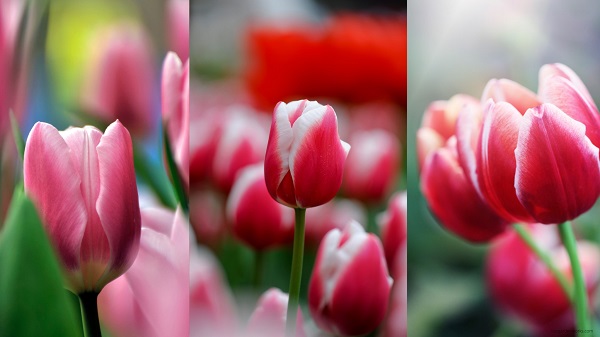
- Tulipa ‘Honeymoon’.
- Tulipa ‘Calgary Flames’.
- Tulipa ‘Don Quichotte’.
- Tulipa ‘Orange Emperor’.
Late-season tulips
Late-season tulips include single, double, and species tulips that bloom around May. They will be the last blooms that can handle a bit of warm temperature as the weather transitions to summer.
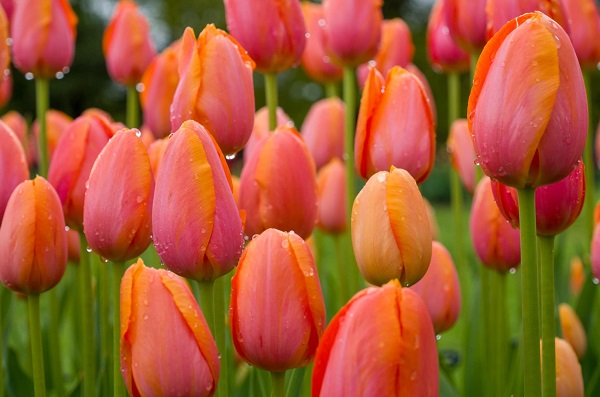
- Tulipa ‘Red Princess’.
- Tulipa ‘Queen of the Night’.
- Tulipa ‘Angelique’.
- Tulipa ‘World Expression’.
- Tulipa ‘Dordogne’.
Find the best location
The best locations to plant tulips are areas where they can receive sun in the morning and shade in the afternoon. Tulips may grow in the ground but they grow best in flower beds and planters.
Tulips also love to be planted in groups or clumps. So, make sure that they’ll have enough space to grow their roots.
Prepare the soil
Sandy and loose soil is the most ideal soil structure for tulips. It must be rich in organic matter like compost or aged manure. For starters, you can mix the following soil components:
- 30% Compost or aged manure.
- 30% Potting mix or garden soil.
- 20% Cocopeat.
- 20% Sand.
The soil in the garden bed should be tilled and turned using a tiller or manual shoveling to aerate the soil and break soil clumps.
Plant the bulbs
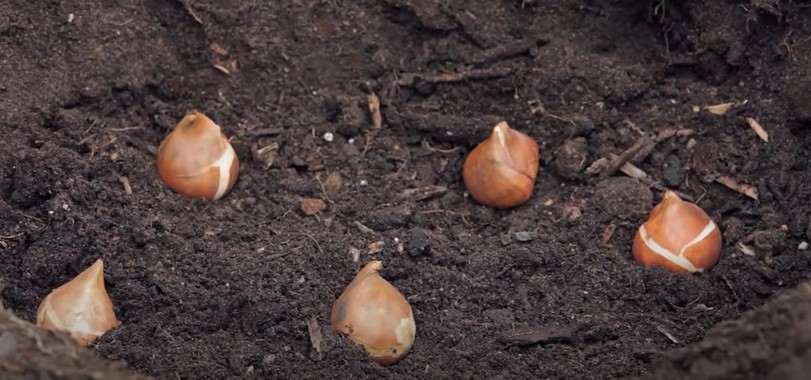
Behind the beautiful blooms of tulips are their onion-like bulbs. You can plant them using seeds but it will take several years before they bloom. So, most gardeners plant bulbs to ensure blooms in the next spring.
The bulbs should be planted in clumps or groups with a 5 to 6 inches distance from each other. Plant them in November before the ground freezes so they can start establishing themselves before winter.
According to Hans Langeveld, a professional gardener, planting the pointed end of the tulip bulb up is a myth because the sprout will still find its way up.
Generally, you can place the bulbs 6 inches deep into the ground but the rule of thumb is to plant them at a depth of two to three times the height of the bulb.
Ideally, plant around 10 to 15 bulbs in a garden bed to achieve a beautiful landscape once they grow in spring.
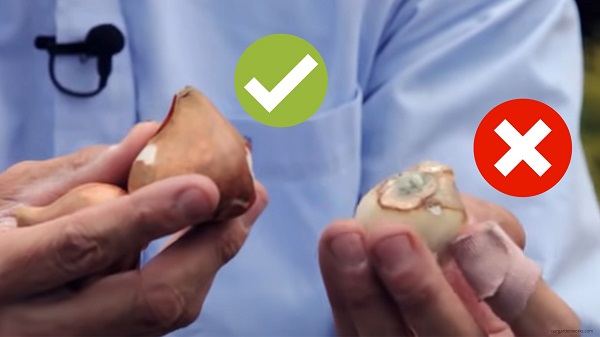
The cracked skin or no skin of tulip bulbs is normal and healthy and does not affect their development. However, if the bulb has discoloration and is mushy, it is no longer ideal for planting.
Water the newly planted bulbs
You should only water the newly planted bulbs if the soil is too dry. However, if you get an adequate amount of rainfall in your region, you can leave them unwatered after planting. They can start establishing themselves without excessive watering since they’re not a fan of wet feet.
Frequently Asked Questions (FAQs)
How many hours of sun do tulips need?
Tulips are photosensitive like other bulbs and need at least 6 hours of full sun for the blooms to open.
During spring, they can thrive in a whole day of exposure to sunlight. However, tulips perform best if they get both sun and partial shade throughout the day.
Do tulips in a vase need sun?
Cut tulips in a vase need indirect sunlight so they’ll open up during the day. Do not place them in direct sunlight to prevent them from wilting.
Tulips are not tolerant of warm and hot temperatures and may show signs of stress like wilting and scorched petals.
Can I plant tulips in the spring?
Yes, you can plant tulips in spring. However, you cannot expect them to bloom immediately. The roots need enough time to establish themselves before they can develop blooms. So, tulips planted in spring will bloom in the next growing season.
Do tulips come back every year?
Tulips are naturally perennial bulbs. However, gardeners notice that once they bloom in one growing season, there is no assurance that they will bloom again in the next spring.
To mitigate the disappointment, they decide to plant new bulbs every fall to have guaranteed blooms in the next spring.
What months do tulips bloom?
Tulips usually bloom from March to May. Some varieties bloom early in the season which is March to April while most tulips bloom from April to May. Late-season tulips usually bloom in May until the weather warms up.
Do tulips open and close with the sun?
Yes, tulips are sensitive to heat and light. They open in the presence of light and close at night. It is part of the photosensitive qualities that are common in bulb plants.
Final Thoughts
We hope that whenever someone asks you if tulips need sun or shade, you can answer them with confidence. Tulips love the combination of sun and shade and will grow best with 6 hours of sunlight.
We hope that this post gave you a brief introduction to tulip cultivation and encouraged you to plant them this fall.
Tulips are very expensive and having them in your garden just levels up the appeal of your landscape. They possess one of the most beautiful flowers in different shades like they come from a painting. Who knows you can also sell some bulbs to your curious neighbors!
Let us know in the comments which tulip variety is your favorite and why. Also, please don’t forget to share this post with your friends and allow them to discover new plant varieties to add in their garden.
